Ultrasound-Assisted Deep Eutectic Solvent Extraction of Antioxidant and Anti-Colorectal Cancer Proteins from Spirulina Biomass: Process Intensification, Characterization, and Bioactivity Evaluation
Abstract
:1. Introduction
2. Materials and Methods
2.1. Algal Biomass
2.2. Preparation of Extraction Solvent
2.3. RSM Optimization of Protein Extraction via Integrated DES Extraction and Ultrasound-Assisted Process
2.4. Characterization of Extracted Proteins
2.4.1. Determination of Protein Content
2.4.2. Determination of Molecular Weight by SDS-PAGE Gel Electrophoresis
2.4.3. Amino Acid Composition
2.4.4. Determination of Impurities
Total Phenolic Content
Total Sugar Content
2.5. Antioxidant Properties
2.5.1. 2-Diphenyl-1-picrylhydrazyl (DPPH) Radical Scavenging Assay
2.5.2. 2,2′-Azino-bis(3-ethylbenzthiazoline-6-sulfonic acid) (ABTS) Radical Scavenging Assay
2.5.3. Potassium-Ferricyanide-Reducing Antioxidant Power (PFRAP) Assay
2.6. Anticancer Properties
2.6.1. Cytotoxicity Assay Against Cancer Cells and Normal Cells
2.6.2. Measurement of the Cell Death by Flow Cytometry
2.7. Functional Properties of Extracted Protein
2.7.1. Solubility
2.7.2. Foaming Capacity and Stability
2.7.3. Emulsifying Capacity and Stability
2.7.4. Digestibility
2.8. Statistical Analysis
3. Results and Discussion
3.1. Optimization of Ultrasound-Assisted Deep Eutectic Solvent Extraction of Protein from Spirulina Biomass
3.1.1. Statistical Analysis
3.1.2. Effect of Parameters on Protein Yield
3.1.3. Numerical Optimization and Verification of the Model
3.2. Characterization of Protein-Rich Extracts from Spirulina Biomass
3.2.1. Protein Content and Impurities
3.2.2. Amino Acids Composition by HPLC Analysis
3.2.3. Molecular Weight Determination by SDS-PAGE
3.3. Antioxidant Activities
3.4. Anticancer Activity
3.5. Functional Properties
3.5.1. Solubility
3.5.2. Foaming Properties
3.5.3. Emulsifying Properties
3.5.4. Digestibility
4. Conclusions
Author Contributions
Funding
Institutional Review Board Statement
Informed Consent Statement
Data Availability Statement
Acknowledgments
Conflicts of Interest
References
- Wang, Y.; Lyu, B.; Fu, H.; Li, J.; Ji, L.; Gong, H.; Zhang, R.; Liu, J.; Yu, H. The development process of plant-based meat alternatives: Raw material formulations and processing strategies. Food Res. Int. 2023, 167, 112689. [Google Scholar] [CrossRef] [PubMed]
- Araújo, R.; Vázquez Calderón, F.; Sánchez López, J.; Azevedo, I.C.; Bruhn, A.; Fluch, S.; Garcia Tasende, M.; Ghaderiardakani, F.; Ilmjärv, T.; Laurans, M. Current status of the algae production industry in Europe: An emerging sector of the blue bioeconomy. Front. Mar. Sci. 2021, 7, 626389. [Google Scholar] [CrossRef]
- Bürck, M.; Fratelli, C.; Campos Assumpção de Amarante, M.; Braga, A.R.C. Unveiling the potential of Spirulina biomass—A Glimpse into the future circular economy using green and blue ingredients. Biomass 2024, 4, 704–719. [Google Scholar] [CrossRef]
- Braune, S.; Krüger-Genge, A.; Kammerer, S.; Jung, F.; Küpper, J.-H. Phycocyanin from Arthrospira platensis as Potential Anti-Cancer Drug. Life 2021, 11, 91. [Google Scholar] [CrossRef]
- Xin, Z.; Zhang, M.; Cui, H.; Ding, X.; Zhang, T.; Wu, L.; Cui, H.; Xue, Q.; Chen, C.; Gao, J. Algae: A robust living material against cancer. Int. J. Nanomed. 2023, 18, 5243–5264. [Google Scholar] [CrossRef]
- Sharma, V.; Tsai, M.-L.; Sun, P.-P.; Chen, C.-W.; Nargotra, P.; Dong, C.-D. Sequential ultrasound assisted deep eutectic solvent-based protein extraction from Sacha inchi meal biomass: Towards circular bioeconomy. J. Food Sci. Technol. 2023, 60, 1425–1434. [Google Scholar] [CrossRef]
- Patra, A.; Prasath, V.A.; Pandiselvam, R. Deep eutectic solvent: An emerging trend for extraction of plant proteins. J. Mol. Liq. 2023, 389, 122887. [Google Scholar] [CrossRef]
- El Achkar, T.; Greige-Gerges, H.; Fourmentin, S. Basics and properties of deep eutectic solvents: A review. Environ. Chem. Lett. 2021, 19, 3397–3408. [Google Scholar] [CrossRef]
- Chen, Q.; Chaihu, L.; Yao, X.; Cao, X.; Bi, W.; Lin, J.; Chen, D.D.Y. Molecular property-tailored soy protein extraction process using a deep eutectic solvent. ACS Sustain. Chem. Eng. 2021, 9, 10083–10092. [Google Scholar] [CrossRef]
- Ashfaq, A.; Younis, K. Ultrasound-assisted Extraction of Plant-Based Proteins: A Novel. Ind. J. Pure App. Biosci. 2021, 9, 145–150. [Google Scholar] [CrossRef]
- Purdi, T.S.; Setiowati, A.D.; Ningrum, A. Ultrasound-assisted extraction of Spirulina platensis protein: Physicochemical characteristic and techno-functional properties. J. Food Meas. Charact. 2023, 17, 5474–5486. [Google Scholar] [CrossRef]
- Braspaiboon, S.; Osiriphun, S.; Surawang, S.; Jirarattanarangsri, W.; Kanha, N.; Laokuldilok, T. Ultrasound-assisted alkaline extraction of proteins in several algae and their nutritional characteristics. Int. J. Food Sci. Technol. 2022, 57, 6143–6154. [Google Scholar] [CrossRef]
- Narukulla, S.; Bogadi, S.; Tallapaneni, V.; Sanapalli, B.K.R.; Sanju, S.; Khan, A.A.; Malik, A.; Barai, H.R.; Mondal, T.K.; Karri, V. Comparative study between the Full Factorial, Box–Behnken, and Central Composite Designs in the optimization of metronidazole immediate release tablet. Microchem. J. 2024, 207, 111875. [Google Scholar] [CrossRef]
- Lowry, O.H.; Rosebrough, N.J.; Farr, A.L.; Randall, R.J. Protein measurement with the Folin phenol reagent. J. Biol. Chem. 1951, 193, 265–275. [Google Scholar] [CrossRef]
- Htoo, N.Y.M.; Kraseasintra, O.; Buncharoen, W.; Kaewkod, T.; Pekkoh, J.; Tragoolpua, Y.; Khoo, K.S.; Chaipoot, S.; Srinuanpan, S.; Pumas, C. In vitro immunomodulation activity of protein hydrolysate from spirulina (Arthrospira platensis): The ingredient of future foods. Front. Mar. Sci. 2024, 11, 1303025. [Google Scholar] [CrossRef]
- Pekkoh, J.; Ruangrit, K.; Pumas, C.; Duangjan, K.; Chaipoot, S.; Phongphisutthinant, R.; Jeerapan, I.; Sawangrat, K.; Pathom-aree, W.; Srinuanpan, S. Transforming microalgal Chlorella biomass into cosmetically and nutraceutically protein hydrolysates using high-efficiency enzymatic hydrolysis approach. Biomass Convers. Biorefin. 2023, 13, 6299–6315. [Google Scholar] [CrossRef]
- Somjai, C.; Siriwoharn, T.; Kulprachakarn, K.; Chaipoot, S.; Phongphisutthinant, R.; Chaiyana, W.; Srinuanpan, S.; Wiriyacharee, P. Effect of drying process and long-term storage on characterization of Longan pulps and their biological aspects: Antioxidant and cholinesterase inhibition activities. LWT 2022, 154, 112692. [Google Scholar] [CrossRef]
- Lomakool, S.; Ruangrit, K.; Jeerapan, I.; Tragoolpua, Y.; Pumas, C.; Srinuanpan, S.; Pekkoh, J.; Duangjan, K. Biological activities and phytochemicals profiling of different cyanobacterial and microalgal biomass. Biomass Convers. Biorefin. 2023, 13, 4195–4211. [Google Scholar] [CrossRef]
- Zin, M.T.; Kaewkod, T.; Pekkoh, J.; Pathom-aree, W.; Chaipoot, S.; Kanthakat, G.; Seesuriyachan, P.; Chen, Y.-Y.; Khoo, K.S.; Cheirsilp, B. Integrated Deep Eutectic Solvent (DES) Extraction and Microwave-Assisted Process for Algal Protein Extraction: Process Improvement, Characterizations, Functional Properties, and Antioxidant and Anti-Colorectal Cancer Potentials. J. Agric. Food Res. 2025, 19, 101673. [Google Scholar] [CrossRef]
- Phinyo, K.; Ruangrit, K.; Pekkoh, J.; Tragoolpua, Y.; Kaewkod, T.; Duangjan, K.; Pumas, C.; Suwannarach, N.; Kumla, J.; Pathom-Aree, W. Naturally occurring functional ingredient from filamentous thermophilic cyanobacterium Leptolyngbya sp. KC45: Phytochemical characterizations and their multiple bioactivities. Antioxidants 2022, 11, 2437. [Google Scholar] [CrossRef]
- Kari, S.; Subramanian, K.; Altomonte, I.A.; Murugesan, A.; Yli-Harja, O.; Kandhavelu, M. Programmed cell death detection methods: A systematic review and a categorical comparison. Apoptosis 2022, 27, 482–508. [Google Scholar] [CrossRef] [PubMed]
- Chaipoot, S.; Phongphisutthinant, R.; Wiriyacharee, P.; Kanthakat, G.; Wongwatcharayothin, W.; Somjai, C.; Danmek, K.; Chuttong, B. Application of Carboxymethyl Cellulose and Glycerol Monostearate as Binder Agents for Protein Powder Production from Honey Bee Brood Using Foam-Mat Drying Technique. Foods 2024, 13, 2265. [Google Scholar] [CrossRef] [PubMed]
- Rawdkuen, S.; D’Amico, S.; Schoenlechner, R. Physicochemical, functional, and in vitro digestibility of protein isolates from Thai and Peru Sacha Inchi (Plukenetia volubilis L.) oil press-cakes. Foods 2022, 11, 1869. [Google Scholar] [CrossRef]
- Veza, I.; Spraggon, M.; Fattah, I.R.; Idris, M. Response surface methodology (RSM) for optimizing engine performance and emissions fueled with biofuel: Review of RSM for sustainability energy transition. Results Eng. 2023, 18, 101213. [Google Scholar] [CrossRef]
- Kingwascharapong, P.; Chaijan, M.; Karnjanapratum, S. Ultrasound-assisted extraction of protein from Bombay locusts and its impact on functional and antioxidative properties. Sci. Rep. 2021, 11, 17320. [Google Scholar] [CrossRef]
- Geng, M.; Thagard, S.M. The effects of externally applied pressure on the ultrasonic degradation of Rhodamine B. Ultrason. Sonochem. 2013, 20, 618–625. [Google Scholar] [CrossRef]
- Shen, L.; Pang, S.; Zhong, M.; Sun, Y.; Qayum, A.; Liu, Y.; Rashid, A.; Xu, B.; Liang, Q.; Ma, H. A comprehensive review of ultrasonic assisted extraction (UAE) for bioactive components: Principles, advantages, equipment, and combined technologies. Ultrason. Sonochem. 2023, 101, 106646. [Google Scholar] [CrossRef]
- Wen, L.; Tan, S.; Zeng, L.; Wang, Z.; Ke, X.; Zhang, Z.; Tang, H.; Guo, H.; Xia, E. Ultrasound-assisted extraction and in vitro simulated digestion of Porphyra haitanensis proteins exhibiting antioxidative and α-glucosidase inhibitory activity. J. Food Meas. Charact. 2020, 14, 3291–3298. [Google Scholar] [CrossRef]
- Silva, S.C.; Almeida, T.; Colucci, G.; Santamaria-Echart, A.; Manrique, Y.A.; Dias, M.M.; Barros, L.; Fernandes, Â.; Colla, E.; Barreiro, M.F. Spirulina (Arthrospira platensis) protein-rich extract as a natural emulsifier for oil-in-water emulsions: Optimization through a sequential experimental design strategy. Colloids Surf. A Physicochem. Eng. Asp. 2022, 648, 129264. [Google Scholar] [CrossRef]
- Guo, X.; Wang, Q.; Yang, Q.; Gong, Z.; Wu, Y.; Liu, X. Effects of molecular structure and charge state on the foaming and emulsifying properties of Spirulina protein isolates. Food Res. Int. 2024, 187, 114407. [Google Scholar] [CrossRef]
- Gorissen, S.H.; Crombag, J.J.; Senden, J.M.; Waterval, W.H.; Bierau, J.; Verdijk, L.B.; van Loon, L.J. Protein content and amino acid composition of commercially available plant-based protein isolates. Amino Acids 2018, 50, 1685–1695. [Google Scholar] [CrossRef] [PubMed]
- Peter, A.P.; Chew, K.W.; Koyande, A.K.; Yuk-Heng, S.; Ting, H.Y.; Rajendran, S.; Munawaroh, H.S.H.; Yoo, C.K.; Show, P.L. Cultivation of Chlorella vulgaris on dairy waste using vision imaging for biomass growth monitoring. Bioresour. Technol. 2021, 341, 125892. [Google Scholar] [CrossRef] [PubMed]
- Davies, R.W.; Jakeman, P.M. Separating the wheat from the chaff: Nutritional value of plant proteins and their potential contribution to human health. Nutrients 2020, 12, 2410. [Google Scholar] [CrossRef]
- Rehman, S.U.; Ali, R.; Zhang, H.; Zafar, M.H.; Wang, M. Research progress in the role and mechanism of Leucine in regulating animal growth and development. Front. Physiol. 2023, 14, 1252089. [Google Scholar] [CrossRef]
- Amaliah, N.; Mahendradatta, M.; Zainal, Z.; Salengke, S. Trends in Natural Flavor Enhancer: A Review on Umami Compounds. In Proceedings of the BIO Web of Conferences, Makassar, Indonesia, 25–26 October 2023; EDP Sciences: Les Ulis, France, 2014; p. 01013. [Google Scholar]
- Oyovwi, M.O.; Atere, A.D. Exploring the medicinal significance of l-Arginine mediated nitric oxide in preventing health disorders. Eur. J. Med. Chem. Rep. 2024, 12, 100175. [Google Scholar] [CrossRef]
- Julianti, E.; Susanti, S.; Singgih, M.; Mulyani, L.N. Optimization of extraction method and characterization of phycocyanin pigment from Spirulina platensis. J. Math. Fundam. Sci 2019, 51, 168–176. [Google Scholar] [CrossRef]
- Minić, S. Bioactive properties of Spirulina-derived phycobiliproteins and phycobilins. Biol. Serbica 2021, 43. [Google Scholar]
- Ramírez-Rodrigues, M.M.; Estrada-Beristain, C.; Metri-Ojeda, J.; Pérez-Alva, A.; Baigts-Allende, D.K. Spirulina platensis protein as sustainable ingredient for nutritional food products development. Sustainability 2021, 13, 6849. [Google Scholar] [CrossRef]
- Rajakumar, M.S.; Muthukumar, K. Influence of pre-soaking conditions on ultrasonic extraction of Spirulina platensis proteins and its recovery using aqueous biphasic system. Sep. Sci. Technol. 2018, 53, 2034–2043. [Google Scholar] [CrossRef]
- Liu, R.; Xing, L.; Fu, Q.; Zhou, G.-H.; Zhang, W.-G. A review of antioxidant peptides derived from meat muscle and by-products. Antioxidants 2016, 5, 32. [Google Scholar] [CrossRef]
- Saiga, A.; Tanabe, S.; Nishimura, T. Antioxidant activity of peptides obtained from porcine myofibrillar proteins by protease treatment. J. Agric. Food Chem. 2003, 51, 3661–3667. [Google Scholar] [CrossRef] [PubMed]
- Cano, A.; Acosta, M.; Arnao, M. A method to measure antioxidant activity in organic media: Application to lipophilic vitamins. Redox Rep. 2000, 5, 365–370. [Google Scholar] [CrossRef] [PubMed]
- Jin, R.; Hao, J.; Yi, Y.; Yin, D.; Hua, Y.; Li, X.; Bao, H.; Han, X.; Egilmez, N.K.; Sauter, E.R. Dietary fats high in linoleic acids impair antitumor T-cell responses by inducing E-FABP–mediated mitochondrial dysfunction. Cancer Res. 2021, 81, 5296–5310. [Google Scholar] [CrossRef]
- Chentir, I.; Hamdi, M.; Li, S.; Doumandji, A.; Markou, G.; Nasri, M. Stability, bio-functionality and bio-activity of crude phycocyanin from a two-phase cultured Saharian Arthrospira sp. strain. Algal Res. 2018, 35, 395–406. [Google Scholar] [CrossRef]
- Shaik, S.; Harikrishnan, N. Evolution of cytotoxicity of the phytopigments Isolated from Spirulina platen sis using MTT assay. J. Popul. Ther. Clin. Pharmacol. 2023, 30, 335–343. [Google Scholar] [CrossRef]
- Bidram, M.; Ganjalikhany, M.R. Bioactive peptides from food science to pharmaceutical industries: Their mechanism of action, potential role in cancer treatment and available resources. Heliyon 2024, 10, e40563. [Google Scholar] [CrossRef]
- Susantiningsih, T.; Fadilah, F.; Retno Prijanti, A.; Silvia Hardiany, N. Molecular Insights into Spirulina platensis Compounds Targeting TNFa and P21 in Delaying Cellular Senescence Mechanisms: An In Silico Approach. Pharmacogn. J. 2024, 16, 809–815. [Google Scholar] [CrossRef]
- Jiang, L.; Wang, Y.; Liu, G.; Liu, H.; Zhu, F.; Ji, H.; Li, B. C-Phycocyanin exerts anti-cancer effects via the MAPK signaling pathway in MDA-MB-231 cells. Cancer Cell Int. 2018, 18, 1–14. [Google Scholar] [CrossRef]
- Jiang, L.; Wang, Y.; Yin, Q.; Liu, G.; Liu, H.; Huang, Y.; Li, B. Phycocyanin: A potential drug for cancer treatment. J. Cancer 2017, 8, 3416. [Google Scholar] [CrossRef]
- Fadl Allah, W.M.; Shemis, M.A.; Abd El Azeem, E.M.; Osman, E.E.; Mamdouh, S. Profiling the volatile composition and cytotoxic assessment of the encapsulated Spirulina Platensis using alginate chitosan nanoparticles. Egypt. J. Chem. 2023, 66, 511–527. [Google Scholar]
- Krapoth, T.C.; Henle, G.S.; Avdyli, M.; Bektić, B.; Schwarzkopf, K.M.; Bešić, L.; Zeuzem, S.; Welsch, C.; Kraus, N.; Ortiz, C. Wanted: Dead or Alive Cells with Propidium Iodide Staining in Liver Tissue. Int. J. Mol. Sci. 2024, 25, 13521. [Google Scholar] [CrossRef] [PubMed]
- Khalil, A.H.; Aidy, E.A.; Said, M.A.; Kebeish, R.; Al-Badwy, A.H. Biochemical and molecular docking-based assessment of Spirulina platensis’s bioactive constituents for their potential application as natural anticancer drug. Algal Res. 2024, 82, 103624. [Google Scholar] [CrossRef]
- Vilg, J.V.; Undeland, I. pH-driven solubilization and isoelectric precipitation of proteins from the brown seaweed Saccharina latissima—Effects of osmotic shock, water volume and temperature. J. Appl. Phycol. 2017, 29, 585–593. [Google Scholar] [CrossRef] [PubMed]
- Grossmann, L.; Weiss, J. Alternative protein sources as technofunctional food ingredients. Annu. Rev. Food Sci. Technol. 2021, 12, 93–117. [Google Scholar] [CrossRef]
- Blasco, L.; Viñas, M.; Villa, T.G. Proteins influencing foam formation in wine and beer: The role of yeast. Int. Microbiol. 2011, 14, 61–71. [Google Scholar]
- Bertsch, P.; Böcker, L.; Palm, A.-S.; Bergfreund, J.; Fischer, P.; Mathys, A. Arthrospira platensis protein isolate for stabilization of fluid interfaces: Effect of physicochemical conditions and comparison to animal-based proteins. Food Hydrocoll. 2023, 136, 108290. [Google Scholar] [CrossRef]
- Akbarbaglu, Z.; Ayaseh, A.; Ghanbarzadeh, B.; Sarabandi, K. Biological stabilization of Arthrospira bioactive-peptides within biopolymers: Functional food formulation; bitterness-masking and nutritional aspects. LWT 2024, 191, 115653. [Google Scholar] [CrossRef]
- Isnaini, L.; Estiasih, T.; Suseno, S.; Lestari, L. The role vegetable proteins to stabilize emulsion: A mini review. In Proceedings of the IOP Conference Series: Earth and Environmental Science, Malang, Indonesia, 6–7 July 2021; IOP Publishing: Bristol, UK, 2021; p. 012036. [Google Scholar]
- Zhang, X.; Wang, Q.; Liu, Z.; Zhi, L.; Jiao, B.; Hu, H.; Ma, X.; Agyei, D.; Shi, A. Plant protein-based emulsifiers: Mechanisms, techniques for emulsification enhancement and applications. Food Hydrocoll. 2023, 144, 109008. [Google Scholar] [CrossRef]
- Lima, R.R.; Vieira, M.E.M.; Campos, N.d.S.; Perrone, Í.T.; Stephani, R.; Casanova, F.; de Carvalho, A.F. Synergism Interactions of Plant-Based Proteins: Their Effect on Emulsifying Properties in Oil/Water-Type Model Emulsions. Appl. Sci. 2024, 14, 8086. [Google Scholar] [CrossRef]
- Matsuyama, S.; Kazuhiro, M.; Nakauma, M.; Funami, T.; Nambu, Y.; Matsumiya, K.; Matsumura, Y. Stabilization of whey protein isolate-based emulsions via complexation with xanthan gum under acidic conditions. Food Hydrocoll. 2021, 111, 106365. [Google Scholar] [CrossRef]
- Fortuin, J.; Hellebois, T.; Iken, M.; Shaplov, A.S.; Fogliano, V.; Soukoulis, C. Stabilising and functional effects of Spirulina (Arthrospira platensis) protein isolate on encapsulated Lacticaseibacillus rhamnosus GG during processing, storage and gastrointestinal digestion. Food Hydrocoll. 2024, 149, 109519. [Google Scholar] [CrossRef]
- Lucakova, S.; Branyikova, I.; Hayes, M. Microalgal proteins and bioactives for food, feed, and other applications. Appl. Sci. 2022, 12, 4402. [Google Scholar] [CrossRef]
- Niccolai, A.; Venturi, M.; Galli, V.; Pini, N.; Rodolfi, L.; Biondi, N.; D’Ottavio, M.; Batista, A.P.; Raymundo, A.; Granchi, L. Development of new microalgae-based sourdough “crostini”: Functional effects of Arthrospira platensis (spirulina) addition. Sci. Rep. 2019, 9, 19433. [Google Scholar] [CrossRef]
- Kaur, L.; Mao, B.; Beniwal, A.S.; Kaur, R.; Chian, F.M.; Singh, J. Alternative proteins vs animal proteins: The influence of structure and processing on their gastro-small intestinal digestion. Trends Food Sci. Technol. 2022, 122, 275–286. [Google Scholar] [CrossRef]
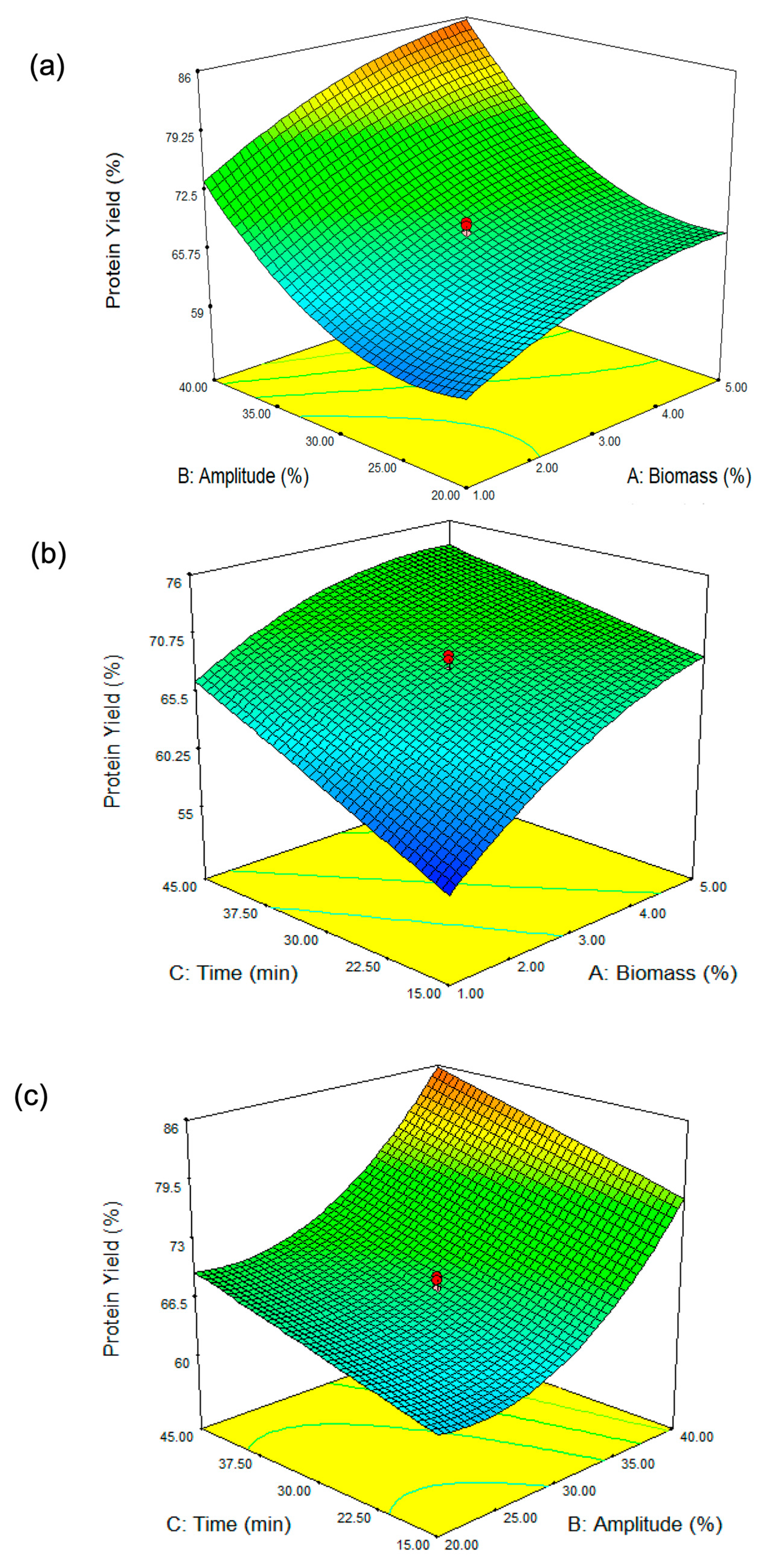
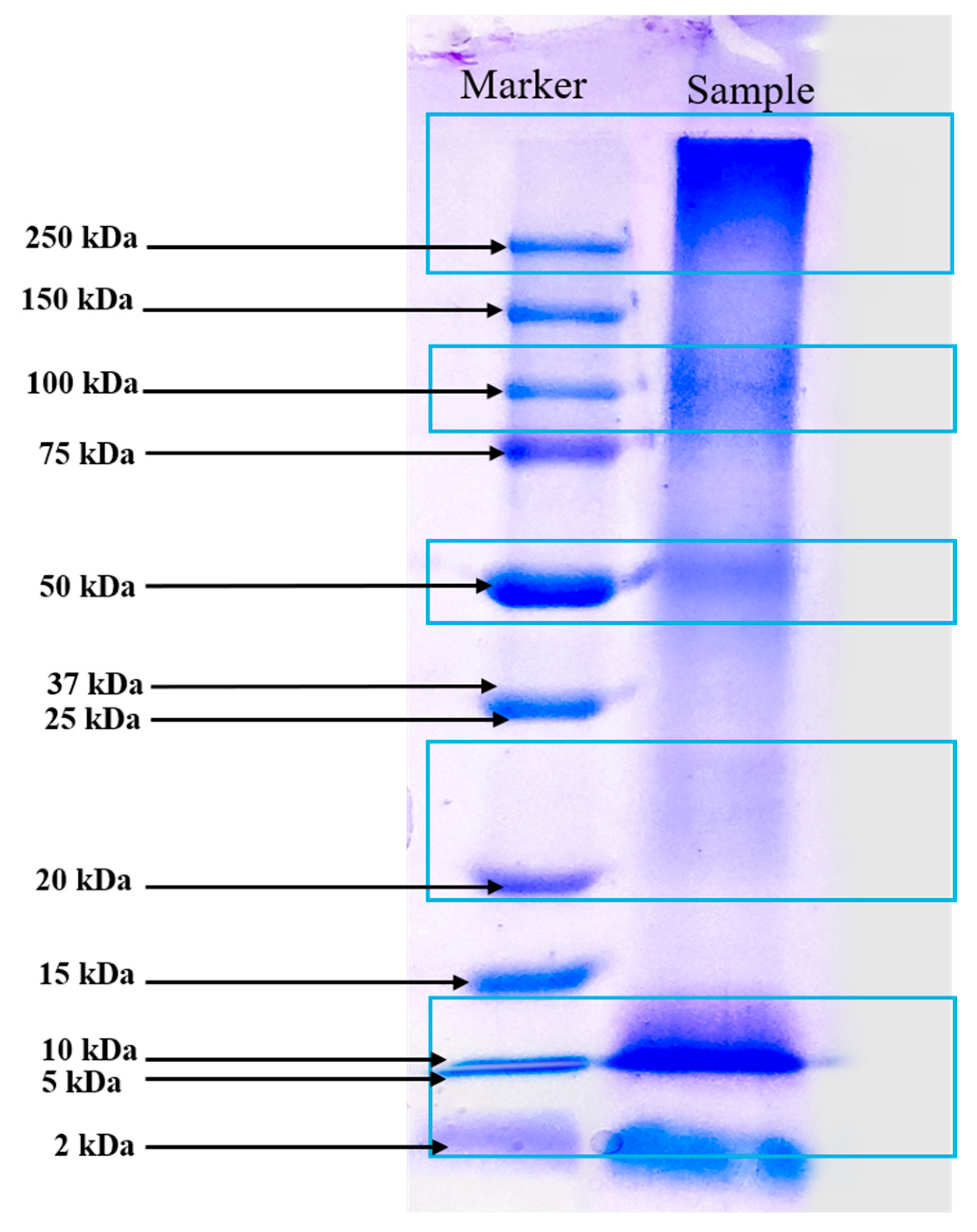
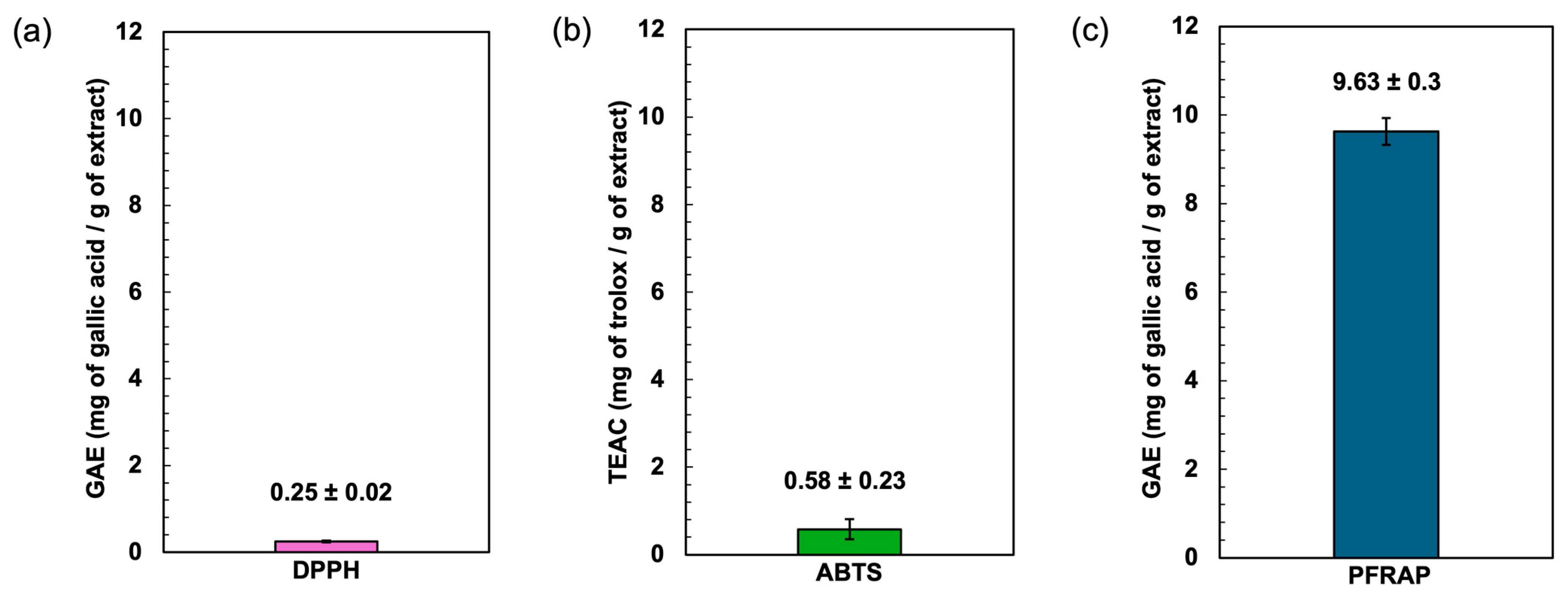
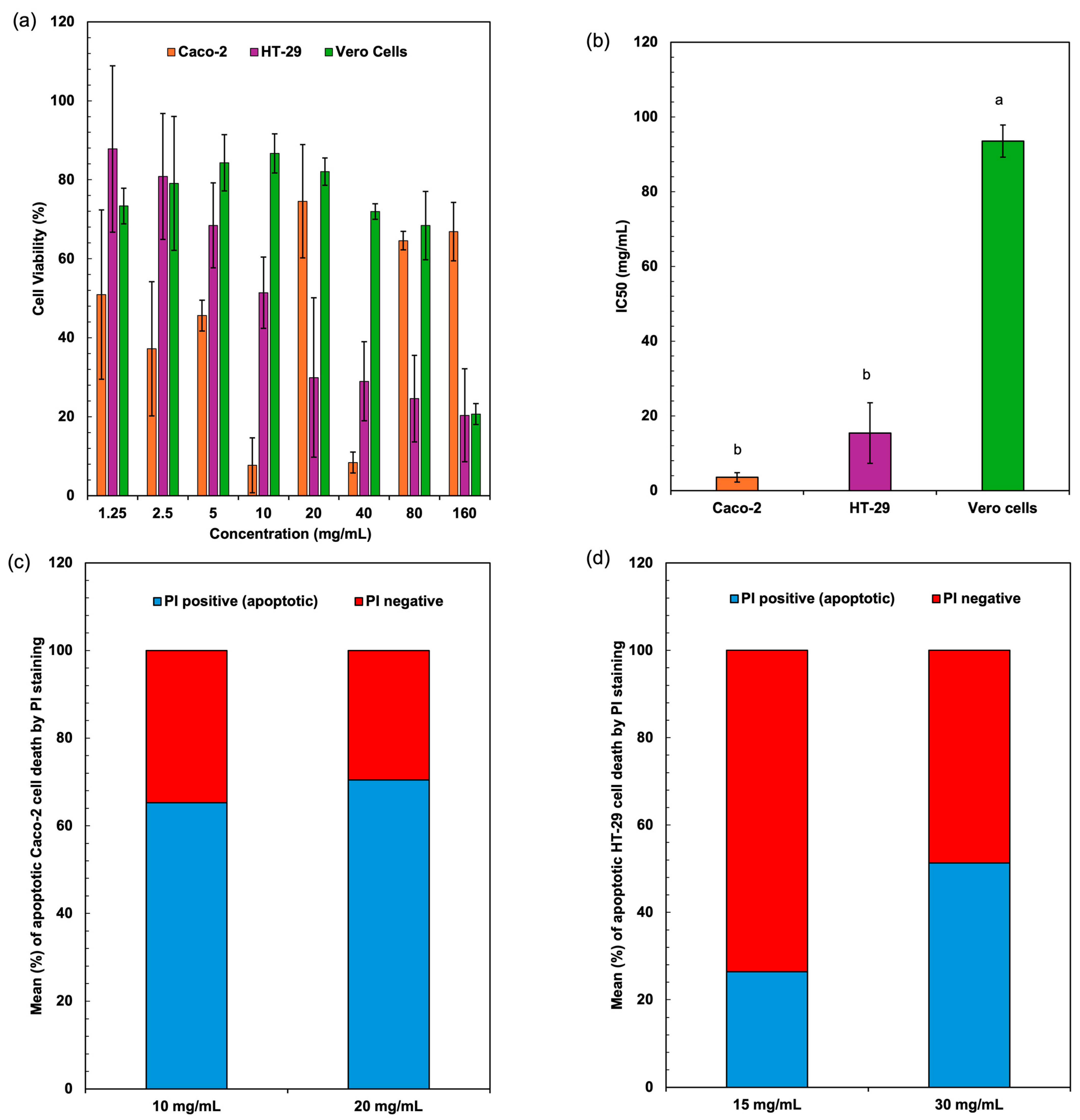
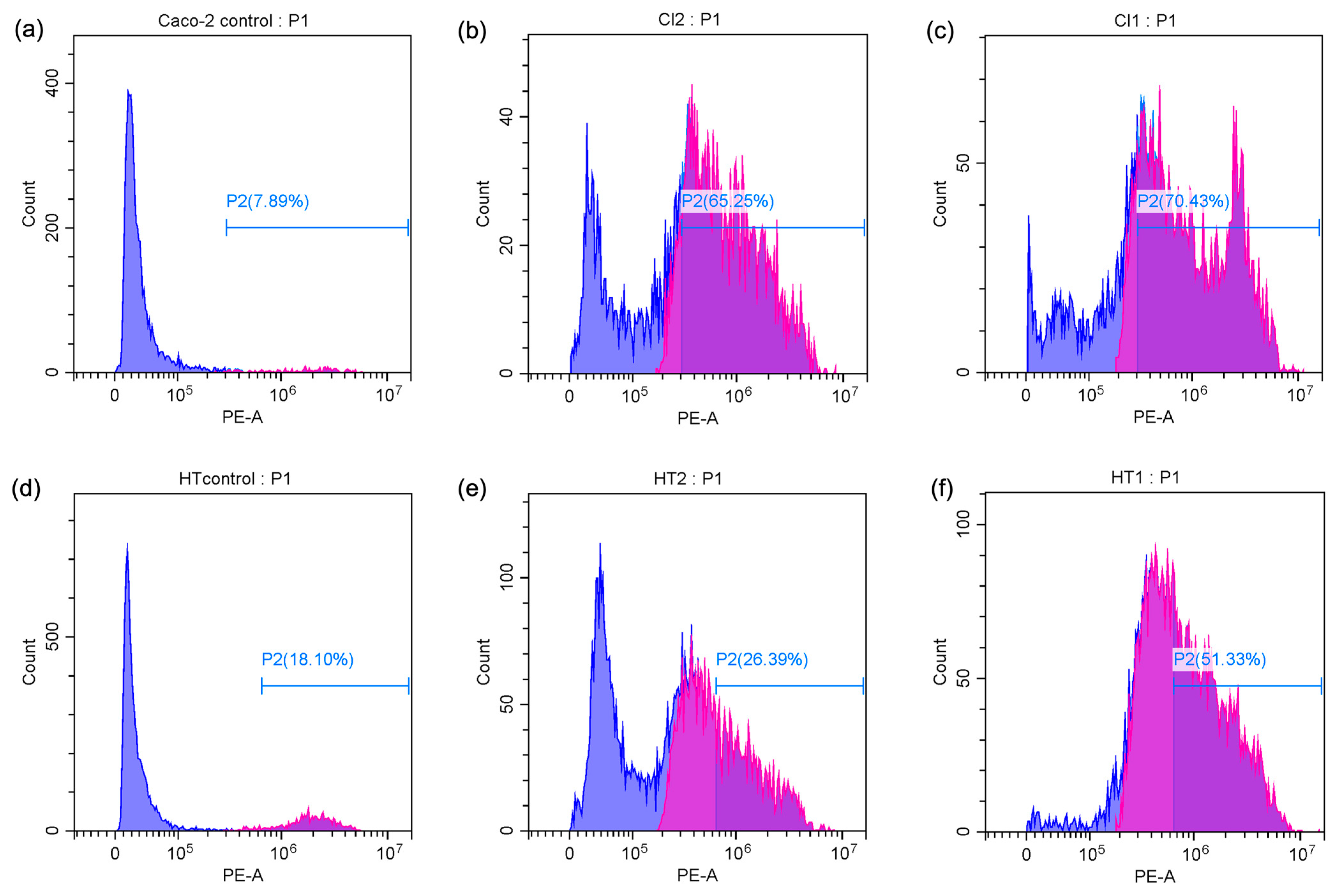
| Run | Biomass Concentration (%) | Amplitude (%) | Time (minutes) | Protein Yield (%) | |
|---|---|---|---|---|---|
| Experimental Value | Predicted Value | ||||
| 1 | 3 | 30 | 30 | 68.53 ± 1.19 | 68.31 |
| 2 | 3 | 30 | 55.23 | 75.73 ± 1.31 | 74.79 |
| 3 | 3 | 30 | 30 | 67.45 ± 1.11 | 68.31 |
| 4 | 5 | 40 | 45 | 88.09 ± 0.09 | 88.29 |
| 5 | 3 | 30 | 30 | 68.98 ± 1.21 | 68.31 |
| 6 | 1 | 20 | 15 | 54.86 ± 0.12 | 54.56 |
| 7 | 3 | 30 | 4.77 | 60.54 ± 1.40 | 61.63 |
| 8 | 3 | 13.18 | 30 | 70.23 ± 0.51 | 70.38 |
| 9 | 6 | 30 | 30 | 70.72 ± 1.80 | 70.87 |
| 10 | 1 | 40 | 15 | 68.60 ± 0.98 | 68.01 |
| 11 | 5 | 40 | 15 | 83.29 ± 0.90 | 82.99 |
| 12 | 5 | 20 | 15 | 66.18 ± 0.93 | 65.46 |
| 13 | 5 | 20 | 45 | 69.43 ± 1.51 | 69.92 |
| 14 | 1 | 40 | 45 | 78.58 ± 0.86 | 79.19 |
| 15 | 1 | 20 | 45 | 64.70 ± 1.14 | 64.90 |
| Source | Sum of Squares | df | Mean Square | F-Value | p-Value | |
|---|---|---|---|---|---|---|
| Model | 976.84 | 9 | 106.28 | 106.28 | <0.0001 | Significant |
| A | 218.35 | 1 | 213.81 | 213.81 | <0.0001 | Significant |
| B | 552.51 | 1 | 552.51 | 541.02 | <0.0001 | Significant |
| C | 208.93 | 1 | 208.93 | 204.58 | <0.0001 | Significant |
| AB | 8.30 | 1 | 8.30 | 8.13 | 0.0358 | Significant |
| AC | 17.32 | 1 | 17.32 | 16.96 | 0.0092 | Significant |
| BC | 0.36 | 1 | 0.36 | 0.35 | 0.5801 | Not significant |
| A2 | 28.22 | 1 | 28.22 | 27.63 | 0.0033 | Significant |
| B2 | 196.28 | 1 | 196.28 | 192.20 | <0.0001 | Significant |
| C2 | 0.014 | 1 | 0.014 | 0.9110 | Not significant | |
| Residual | 5.11 | 5 | 1.02 | |||
| Lack of Fit | 3.87 | 3 | 1.29 | 2.09 | 0.3403 | Not significant |
| Pure Error | 1.24 | 2 | 0.62 | |||
| Cor Total | 981.95 | 14 | ||||
| R2 | 0.9948 | |||||
| Adequate Precision | 40.882 |
| Parameters | Extracted Protein from Spirulina |
|---|---|
| Protein concentration (mg/g extract) | 442.88 ± 13.70 |
| Total phenolic GAE (mg gallic acid/g extract) | 4.87 ± 2.34 |
| Total sugar (mg/mL) | 0.18 ± 0.03 |
| Amino Acids (g/100 g) | Protein Extract | WHO/FAO/UNU | |
|---|---|---|---|
| Children | Adult | ||
| Aspartic acid | 3.18 | NA | NA |
| Threonine a | 1.92 | 2.5 | 2.3 |
| Serine | 2.91 | NA | NA |
| Glutamic acid | 10.38 | NA | NA |
| Proline | 0.33 | NA | NA |
| Glycine | 1.05 | NA | NA |
| Alanine | 4.16 | NA | NA |
| Cysteine | 0.04 | NA | NA |
| Methionine a | 0.36 | 2.4 | 2.2 |
| Valine a | 2.46 | 4.0 | 3.9 |
| Isoleucine a | 2.52 | 3.1 | 3.0 |
| Leucine a | 7.32 | 6.1 | 5.9 |
| Tyrosine | 2.08 | NA | NA |
| Phenylalanine a | 2.88 | 4.1 | 3.8 |
| Histidine a | 0.63 | 1.6 | 1.5 |
| Lysine a | 0.33 | 4.8 | 4.5 |
| Arginine | 3.70 | NA | NA |
| Acidic b | 29.27 | ||
| Basic b | 10.07 | ||
| Hydrophilic b | 38.62 | ||
| Hydrophobic b | 50.11 | ||
| EAA b | 39.91 | ||
| Functional Properties | Extracted Protein from Spirulina |
|---|---|
| Solubility | 3.70 ± 0.10% |
| Foaming capacity (FC) | 100 ± 0% |
| Foaming stability (FS) | 98.01 ± 0.14% |
| Emulsifying capacity (EC) | 94.05 ± 1.69% |
| Emulsifying stability (ES) | 92.86 ± 0.00% |
| Digestibility (%) | 85.77 ± 0.30% |
Disclaimer/Publisher’s Note: The statements, opinions and data contained in all publications are solely those of the individual author(s) and contributor(s) and not of MDPI and/or the editor(s). MDPI and/or the editor(s) disclaim responsibility for any injury to people or property resulting from any ideas, methods, instructions or products referred to in the content. |
© 2025 by the authors. Licensee MDPI, Basel, Switzerland. This article is an open access article distributed under the terms and conditions of the Creative Commons Attribution (CC BY) license (https://creativecommons.org/licenses/by/4.0/).
Share and Cite
Zin, M.T.; Kaewkod, T.; Chaipoot, S.; Kanthakat, G.; Chen, Y.-Y.; Cheirsilp, B.; Srinuanpan, S. Ultrasound-Assisted Deep Eutectic Solvent Extraction of Antioxidant and Anti-Colorectal Cancer Proteins from Spirulina Biomass: Process Intensification, Characterization, and Bioactivity Evaluation. Antioxidants 2025, 14, 365. https://doi.org/10.3390/antiox14030365
Zin MT, Kaewkod T, Chaipoot S, Kanthakat G, Chen Y-Y, Cheirsilp B, Srinuanpan S. Ultrasound-Assisted Deep Eutectic Solvent Extraction of Antioxidant and Anti-Colorectal Cancer Proteins from Spirulina Biomass: Process Intensification, Characterization, and Bioactivity Evaluation. Antioxidants. 2025; 14(3):365. https://doi.org/10.3390/antiox14030365
Chicago/Turabian StyleZin, May Thu, Thida Kaewkod, Supakit Chaipoot, Gochakorn Kanthakat, Yan-Yu Chen, Benjamas Cheirsilp, and Sirasit Srinuanpan. 2025. "Ultrasound-Assisted Deep Eutectic Solvent Extraction of Antioxidant and Anti-Colorectal Cancer Proteins from Spirulina Biomass: Process Intensification, Characterization, and Bioactivity Evaluation" Antioxidants 14, no. 3: 365. https://doi.org/10.3390/antiox14030365
APA StyleZin, M. T., Kaewkod, T., Chaipoot, S., Kanthakat, G., Chen, Y.-Y., Cheirsilp, B., & Srinuanpan, S. (2025). Ultrasound-Assisted Deep Eutectic Solvent Extraction of Antioxidant and Anti-Colorectal Cancer Proteins from Spirulina Biomass: Process Intensification, Characterization, and Bioactivity Evaluation. Antioxidants, 14(3), 365. https://doi.org/10.3390/antiox14030365









